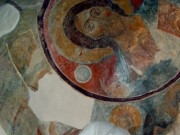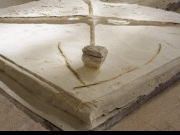Wall-painting Conservation Workshop
History
The collection consists of 233 sections of wall-paintings painted using the fresco or secco techniques; the sections have been detached from various monuments around Greece. The detachment of these works from their original environment began in the late 19th century, and was conducted by non-specialist craftsmen of the time in an effort to save them. The detachments – in most cases from ruined churches – continued into the first half of the 20th century. The works’ restoration was initially undertaken by external collaborators of the Museum, including Fotis Kontoglou and Spyridon Pelekasis, who were also charged with creating copies of the wall-paintings for display in the BCM.
The wall-painting conservation laboratory was formed in 1963, and its pioneering conservators – Fotis Zachariou, Tasos Margaritof, Stavros Baltogiannis, Stavros Papageorgiou et al. – set to work conserving a large number of works.
Under their guidance, the wall-painting conservation effort would expand beyond the Museum to Byzantine and post-Byzantine monuments around Greece, where conservation was conducted in situ. The conservation teams would be bolstered between 1969-1971 by specialists trained in the Museum’s own Training School for Conservators of Antiquities.
There was a hiatus in the activities of the wall-painting laboratory between 1980, when 30 wall-paintings from Episkope, a village in Evrytania, Central Greece, were conserved and exhibited, and 1999, when the laboratory resumed its work in new facilities at the BCM which four conservators have undertaken to reorganize and equip with contemporary equipment.
The laboratory today
The works in the Museum’s wall-painting collection have been subject to numerous and varied interventions during their time at the BCM. The methods and materials used have always reflected the prevailing wisdom and trends of their era, as well as the views of earlier conservators on conservation and aesthetic reintegration.
Today, the laboratory’s primary concern is to protect and study these works in accordance with contemporary practices, the conservators’ professional code of conduct and international conventions. The decision to undertake conservation is always taken motivated by the need to slow decay, and the core philosophy of minimizing intervention.
The laboratory’s focus is thus on preventive conservation and in dealing with earlier interventions. When it is judged necessary, the conservation of wall-paintings which have already been subject to conservation is a complex and demanding task, as the different techniques and materials used in the past have to be thoroughly studied before any decision can be made regarding their reversal.
All new conservation processes are documented in full, and every effort is made to locate both records detailing older interventions and information on the monuments from which the works were originally removed. The conservators’ aim is to create an inclusive archive documenting both the wall-paintings and their conservational interventions; this chimes with the Museum’s goal to serve as a centre for the study and documentation of the history of Greek conservation.
The laboratory also conducts research into new methods and materials that can be applied to the conservation of detached wall-paintings in general, and to the use of new types of support structure in particular.
An especially demanding task is the transportation, mounting and display of wall-paintings for the purposes of permanent and temporary exhibitions, since the size and weight of the works requires special handling and provisions.














